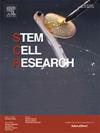由携带KCNH2突变(c. 2690 a > c)的患者产生的人诱导多能干细胞系XXMUFAi001-A。
IF 0.8
4区 医学
Q4 BIOTECHNOLOGY & APPLIED MICROBIOLOGY
引用次数: 0
摘要
2型长QT综合征(LQT2)由KCNH2基因突变引起,是一种与青少年猝死相关的遗传性离子通道障碍。在这项研究中,我们使用非整合的仙台重编程技术从携带杂合点突变(c.2690)的个体中生成了患者特异性诱导多能干细胞(iPSC)系XXMUFAi001-A在KCNH2中的>C)。XXMUFAi001-A细胞系表现出多能性标记的表达,并在体内表现出畸胎瘤形成能力,以及向所有三种胚层分化的潜力。XXMUFAi001-A的建立对于研究LQT2的发病机制和药物筛选具有重要意义。本文章由计算机程序翻译,如有差异,请以英文原文为准。
Human induced pluripotent stem cell line XXMUFAi001-A generated from a patient harboring KCNH2 mutation (c. 2690 A>C)
Long QT syndrome type 2 (LQT2), caused by mutations in the KCNH2 gene, is an inherited ion channel disorder associated with sudden death in adolescents. In this study, we generated a patient-specific induced pluripotent stem cell (iPSC) line XXMUFAi001-A using non-integrative Sendai reprogramming technology from an individual carrying a heterozygous point mutation (c.2690 A>C) in KCNH2. XXMUFAi001-A cell line exhibited expression of pluripotency markers and demonstrated teratoma formation capability in vivo, as well as the potential to differentiate into all three germ layers. The establishment of XXMUFAi001-A is crucial for investigating the pathogenesis and drug screening of LQT2.
求助全文
通过发布文献求助,成功后即可免费获取论文全文。
去求助
来源期刊

Stem cell research
生物-生物工程与应用微生物
CiteScore
2.20
自引率
8.30%
发文量
338
审稿时长
55 days
期刊介绍:
Stem Cell Research is dedicated to publishing high-quality manuscripts focusing on the biology and applications of stem cell research. Submissions to Stem Cell Research, may cover all aspects of stem cells, including embryonic stem cells, tissue-specific stem cells, cancer stem cells, developmental studies, stem cell genomes, and translational research. Stem Cell Research publishes 6 issues a year.
 求助内容:
求助内容: 应助结果提醒方式:
应助结果提醒方式:


